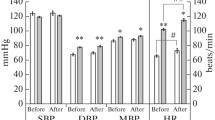Abstract
The results of the analysis of materials on the expert assessment of 66 healthy pilots subjected to a passive orthostatic stress test (POT) by the generally accepted technique of a 20-min head-down tilt bed rest at an angle of 80° to the horizontal are presented. The obtained hemodynamic responses to the test were typified using the generally accepted concepts of functional classes (FC). A good POT tolerance was recorded in 86.4% of the observations, with 36.4% assigned to the first functional class (FC-I) and 50%, to the second functional class (FC-II). A satisfactory orthostatic test tolerance (FC-III) was recorded in 10.6% of the observations, whereas a reduced and poor tolerance (FC-IV and FC-V) was found in 3% of the observations. According to ECGs and computer-assisted tachooscillography, subjects of the FC-I group reached the optimum indicators in their adaptive hemodynamic responses, compared to the pilots of the FC-II group and, particularly, the FC-III group. The latter two groups were found to exhibit some previously unknown objective symptoms, such as marked blood pressure (BP) lability and reversible hypo- and hypertensive responses, which allowed us to differentiate the FC-I pilots from the latter two groups. Based on the obtained results, additional clinical functional tolerance assessment criteria have been developed for a passive orthostatic test as part of the medical expert assessment of flight personnel with different levels of functional stability.
Similar content being viewed by others
References
Baevskii, R.M., Tank, I., Chernikova, A.G., and Graves, K.F., Assessment of Cardiovascular Homeostasis Based on the Use of Mathematical Simulation: Experiment with 120-Day Anti-Orthostatic Hypokinesia, in Kosmicheskaya biologiya i aviakosmicheskaya meditsina: Tezisy dokl (Space Biology and Aerospace Medicine: Abstracts), Moscow, 1998, vol. 1, p. 74.
Belkaniya, G.S., On the Problem of Blood Redistribution in Orthostasis, Kosm. Biol. Med., 1981, vol. 15, no. 6, p. 4.
Belkaniya, G.S. and Dartsmeliya, V.A., Comparative Characterization of the Central Hemodynamics and Redistributional Responses of Blood Flow in Active and Passive Orthostasis, Kosm. Biol. Med., 1985, vol. 19, no. 1, p. 31.
Benevolenskaya, T.V., Study of Bioelectrical Activity of Myocardium under Rassive Orthostatic Test, Kosm. Biol. Med., 1975, vol. 9, no. 4, p. 84–87.
Buyanov, P.V. and Pisarenko, N.V., Orthostatic Test in the Professional Expertise of Pilots and Cosmonauts, in Kosmicheskaya biologiya i aviakosmicheskaya meditsina (Space Biology and Aerospace Medicine) (Abstr. 1st All-Union Conf.), Moscow, 1972, vol. 1, p. 28.
Vartbaronov, R.A., Bondareva, S.V., Bagaudinov, K.G., et al., The Phasic Nature of Adaptive Hemodynamic Responses in Healthy Pilots during Passive Orthostatic Test, in Chelovek v ekstremal’nykh usloviyakh: zdorov’ye, nadezhnost’ i reabilitatsiya Mater. V Mezhdunar. nauchn.-pract. kongressa, (Humans under Extreme Conditions: Health, Reliability, and Rehabilitation) (Proc. V Int. Congress/Workshop), Moscow, 2006, p. 121.
Vartabaronov, R.A., Bukhtiyarov, I.V., and Khomenko, M.N., Identification-Related Aspects in the Pathogenesis of Gravity-Induced Dysfunctions Caused by Flight Overload Effects and Orthostasis, in Kosmicheskaya biologiya i aviakosmicheskaya meditsina (Space Biology and Aerospace Medicine) (Abstr. XIII Conf.), Moscow, 2006, p. 52.
Degtyarev, V.A., Dovzhenko, Yu.M., Larionova, L.A., et al., Prediction of Orthostatic Post-Flight Test Tolerance Based on the Results of Preflight Tests in Cosmonauts, Kosm. Biol. Med., 1982, vol. 16, no. 4, p. 83.
Zaitsev, V.M., Liflyandskii, V.G., and Marinkin, V.I., Prikladnaya meditsinskaya statistika (Applied Medical Statistics), St. Petersburg, 2003.
Kalinichenko, V.V., Asyamolov, B.F., and Zhernavkov, A.F., Orthostatic Stability in Cosmonauts after 30- and 63-Day Flights on Salyut-24 Orbital Station, Kosm. Biol. Aviakosm. Med, 1976, vol. 10, no. 5, p. 18.
Kalinichenko, V.V., Orthostatic Stability Dynamics in Cosmonauts after Space Flights Lasting from 2 to 63 Days, Kosm. Biol. Aviakosm. Med., 1977, vol. 11, no. 3, p. 31.
Karlov V.N. Diagnostics, Nonmedicamentous Correction of the Body’s Functional State and the Ways of Medical Flight Expertise Improvement, Extended Abstract of Dr. Sci. (Med.) Dissertation, 1995.
Karpman, V.L., Belotserkovskii, Z.B., and Gudkov, I.A., Testirovanie v sportivnoi meditsine (Testing in Sports Medicine), Moscow, 1988.
Lakin, G.F., Biometriya (Biometry), Moscow, 1980.
Metodiki issledovanii v tselyakh vrachebno-letnoi ekspertizy: (Pos. dlya chlenov vrachebno-letnykh komissii) (Study Methods for the Medical Flight Expertise: Guidelines for Members of Medical Flight Commissions), Berezhnova, V.S. and Slepenkov, P.L. Eds., Moscow, 1995.
Suvorov, P.M., Karlov, V.N., and Sidorova, K.A., Methodical Approaches to the Orthostatic Stability Tolerance Assessment, in Spetsial’naya funktsional’naya diagnostika vo vrachebno-letnoi ekspertize (Special Functional Diagnostics in Medical Flight Expertise), Moscow, 1996, p. 129.
Fomina, G.A., Kotovskaya, A.R., Pochuev, V.I., and Zhernavkov, A.F., Changes in the Hemodynamic Mechanisms Supporting Human Orthostatic Stability during Long-Duration Space Flights, Aviakosm. Ekol. Med., 2005, vol. 39, no. 6, p. 9.
Fomina, G.A., Kotovskaya, A.R., Zhernavkov, A.F., and Pochuev, V.I., Association of Hemodynamic Disorders in Cosmonauts with Orthostatic Stability in Short-Term Space Flight Conditions, Aviakosm. Ekol. Med, 2005, vol. 39, no. 3, p. 14.
Fomina, G.A., Kotovskaya, A.R., Zhernavkov, A.F., and Pochuev, V.I., Possibilities of Predicting Orthostatic Stability in Cosmonauts in Long-Duration Space Flights, Aviakosm. Ekol. Med., 2007, vol. 41, no. 4, p. 20.
Dikahit, M.B., Banerje, P.K., and Rao, P.L.N., Orthostatic Tolerance of Normal Indians and Those with Suspected Abnormal Cardiovascular Reflex Status, Aviat., Space Environ. Med., 1986, vol. 57, p. 168.
Grimm, J.J., Orthostatic Hypotension, STAR, 1981, vol. 19, no. 7, p. 955.
Howard, P., Gravity and the Circulation: Proceeding Royal Society London, 1977, vol. 199, no. 1137, p. 485.
Landmark, K. and Kravik, S., The Use of Antigravity Suits in the Treatment of Idiopathic Orthostatic Hypotension, Sci. Tech. Aerosp. Rep., 1980, vol. 18, no. 17, p. 2329.
Author information
Authors and Affiliations
Additional information
Original Russian Text © S.V. Bondareva, R.A. Vartbaronov, K.V. Ponomarenko, K.G. Bagaudinov, M.N. Khomenko, N.N. Uglova, 2009, published in Aviakosmicheskaya i Ekologicheskaya Meditsina, 2009, Vol. 43, No. 1, pp. 26–32.
Rights and permissions
About this article
Cite this article
Bondareva, S.V., Vartbaronov, R.A., Ponomarenko, K.V. et al. Resistance and hemodynamic reactions in healthy pilots under the conditions of passive orthostatic loading. Hum Physiol 38, 745–750 (2012). https://doi.org/10.1134/S0362119712070055
Received:
Published:
Issue Date:
DOI: https://doi.org/10.1134/S0362119712070055



